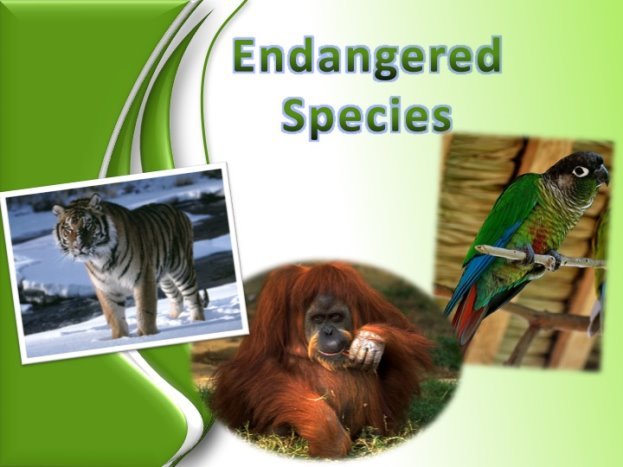Конспект уроку англійської мови у 9 класі "Endangered Species"

Compiled by Lilia Tkachuk
School #1 of Ratne
Endangered Species
Level – A2
Objectives: to present to pupils the animals of endangered species;
to develop pupils' listening skills;
to improve reading skills;
to encourage their speaking.
Equipment: multimedia presentations, cards with tasks and texts.
Procedure
- Warming-Up.
T: Good morning, pupils! How are you today? I hope you are fine. So, let's start our lesson. Firstly, look at the photos and say what you know about these animals? What is similar about them?
Pupils give their ideas.
T: All that you have said is right, but there is one more feature about these animals. They are extincting. The ecologist call them endangered species. So, the topic of our discussion is endangered species. According to The Free Dictionary the explanation of this word combination is: Endangered species - a species whose numbers are so small that the species is at risk of extinction.
The pupils read the explanation.
- Main part.
1. Speaking.
T: Let’s complete the sentences:
- An endangered species is…
- Many countries have laws offering…
- The conservation status of a species is…
- Many factors are taken into account when…
T: I've recieved a letter from Youth organization «Lovers of Nature». They are looking for the children of your age for cooperation. You will join them if you answer their questions. Have a try to ask questions for each group.
- Why is the protection of animals important?
- What different factors threaten their existence?
- What endangered species of animals do you know?
- Do you think endangered species of animals should be bred up in captivity or live in the wild?
- Do you think zoos are good and useful places, or prisons for animals?
- What are the most popular pets nowadays?
- Are there organizations which try to save the animals for future?
- What is the law which protects animals?
2. Reading.
T: I suggest you to read the text about very beautiful and colourful bird, which is extincted now. This bird is called Carolina Parakeet. But, first of all listen to its very pleasant singing.
The pupils read the text Ex. 1, P. 37 (WB). They complete the sentences with the correct word and make up the questions and answer them.
The Extinction of Carolina Parakeet
The Carolina parakeet was the only native parrot in North America. It was a colourful bird with a yellow head, orange cheeks and a green body.
The Carolina parakeet inhabited forests and nested in tree cavities. Fruits and seeds of trees were its main source of food. Outside the breeding season they formed large noisy flocks that fed on cultivated fruits, corn and other grain crops. Soon they were considered to be a serious danger for the crops and the farmers followed them with violence. As settlers occupied more areas, forests were cleared and large trees which had cavities, were cut down. Those birds were also caught and sold as pets. By 1800 the parakeet had become a rare species. Soon the bird became extinct today we have only specimens of the Carolina parakeet to study in the museum.
a b c
1 original nature native
2 coloured colourful colouring
3 located inhabited lived
4 formed shaped built
5 weighed considered supposed
6 where whose which
7 as so for
8 species opinion sight
9 single only lonely
- the/live/did/Where/parrots?
- look/did/the/How/like/parrots?
- eat/What/birds/did/the?
- the/dangerous/the/were/Why/farmers/birds/for?
- we/today/the/study/can/Where/parrot?
3. Relaxation.
T: Let’s relax. Listen to a nice song “Mother Nature’s Son” which is performed by famous English group “The Beatles”. You are to put the pictures according to this song in right order during the listening.
The pupils check up themselves with the picture at the project screen.
4. Presentation of the lexical units.
T: I want to present to you endangered species of wild world. Let’s guess what are they. The pupils name the animals according to the pictures.
T: Which of these animals would you most like to save?
The children give the ideas.
QUIZ.
T: Let’s guess what animals I will describe. For each right answer I’ll give you a green leaf, a symbol of nature.
- The female lay eggs. (A giant turtle)
- Being an inhabitant of Australia it is one of the symbols of the country. (A kangaroo)
- Although they are birds, they cannot fly. (A kiwi)
- There are only 10 000 left of them. (A polar bear)
- They are entertainers in water shows. (A sea lion)
- When attacked, they hide under their shells that protect them from larger animals. (A giant turtle)
- They live in salt and fresh water coastal areas around Florida. (A sea cow)
- They are very skillful with balls. (A sea lion)
- This animal doesn’t run, but hops. (A kangaroo)
- They have a special thumb like finger, which helps them in eating. (A panda)
- They are becoming extinct nowadays as they are losing their habitats, because of the global warming. (A polar bear)
- They are the largest living animals on the Earth. (An elephant)
- They live in China. (A panda)
- There is a small oval fruit of the same name. (A kiwi)
- They are mammals, living under water. (A sea cow)
- Mother animals carry their animals for 20-22 months. (An elephant)
5. Project work.
The teacher presents texts about endangered species to each group. The kids are to make project work paying attention for description of the animal, habitat, food, causes of extinction.
The children present their projects to the class.
- Summing-Up
“Tree of solutions”.
The pupils write their recommendations in groups: what they should do in order to protect endangered species, to stop the extinction.
The children complete the quote: Air, water and soil pollution, littering, destruction of woods! The people are terribly worried. The animals are extincting. They are in danger. Let’s save and protect __________ ______! (Endangered species)
T: If you would start to do this in your everyday life and in your nearest future this animals would be very grateful. I see, everyone is a “Lover of Nature” and will join the Youth organization. These badges are your permissions.
The teacher gives the badges to the pupils.
Home assignment.
Ex. 8, P. 77 (SB) Ex. 3, P. 38 (WB)


про публікацію авторської розробки
Додати розробку
